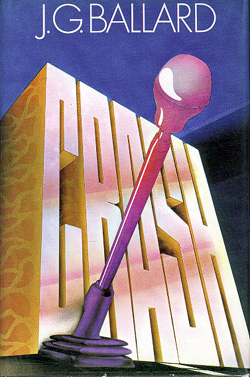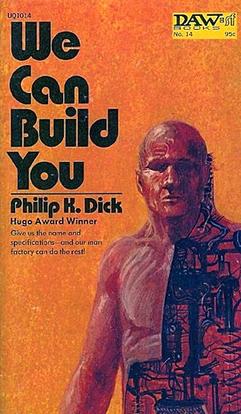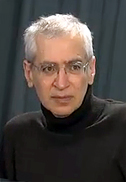
Crash is a novel by English author J. G. Ballard, first published in 1973 with cover designed by Bill Botten. It follows a group of car-crash fetishists who become sexually aroused by staging and participating in car accidents, inspired by the famous crashes of celebrities.
Nihilism is a family of views within philosophy that rejects generally accepted or fundamental aspects of human existence, such as knowledge, morality, or meaning. The term was popularized by Ivan Turgenev and more specifically by his character Bazarov in the novel Fathers and Sons.
Post-structuralism is a philosophical movement that questions the objectivity or stability of the various interpretive structures that are posited by structuralism and considers them to be constituted by broader systems of power. Although post-structuralists all present different critiques of structuralism, common themes among them include the rejection of the self-sufficiency of structuralism, as well as an interrogation of the binary oppositions that constitute its structures. Accordingly, post-structuralism discards the idea of interpreting media within pre-established, socially constructed structures.
Truth or verity is the property of being in accord with fact or reality. In everyday language, truth is typically ascribed to things that aim to represent reality or otherwise correspond to it, such as beliefs, propositions, and declarative sentences.

Jean Baudrillard was a French sociologist, philosopher and poet, with interest in cultural studies. He is best known for his analyses of media, contemporary culture, and technological communication, as well as his formulation of concepts such as hyperreality. Baudrillard wrote about diverse subjects, including consumerism, critique of economy, social history, aesthetics, Western foreign policy, and popular culture. Among his most well-known works are Seduction (1978), Simulacra and Simulation (1981), America (1986), and The Gulf War Did Not Take Place (1991). His work is frequently associated with postmodernism and specifically post-structuralism. Nevertheless, Baudrillard had also opposed post-structuralism, and had distanced himself from postmodernism.
Hyperreality is a concept in post-structuralism that refers to the process of the evolution of notions of reality, leading to a cultural state of confusion between signs and symbols invented to stand in for reality, and direct perceptions of consensus reality. Hyperreality is seen as a condition in which, because of the compression of perceptions of reality in culture and media, what is generally regarded as real and what is understood as fiction are seamlessly blended together in experiences so that there is no longer any clear distinction between where one ends and the other begins.

The Gulf War Did Not Take Place is a collection of three short essays by Jean Baudrillard published in the French newspaper Libération and British paper The Guardian between January and March 1991.

Simulacra and Simulation is a 1981 philosophical treatise by the philosopher and cultural theorist Jean Baudrillard, in which he seeks to examine the relationships between reality, symbols, and society, in particular the significations and symbolism of culture and media involved in constructing an understanding of shared existence.
French philosophy, here taken to mean philosophy in the French language, has been extremely diverse and has influenced Western philosophy as a whole for centuries, from the medieval scholasticism of Peter Abelard, through the founding of modern philosophy by René Descartes, to 20th century philosophy of science, existentialism, phenomenology, structuralism, and postmodernism.

We Can Build You is a 1972 science fiction novel by American writer Philip K. Dick. Written in 1962 as The First in Our Family, it remained unpublished until appearing in serial form as A. Lincoln, Simulacrum in the November 1969 and January 1970 issues of Amazing Stories magazine, re-titled by editor Ted White. The novel was issued as a mass market paperback original by DAW Books in 1972, its final title provided by publisher Donald A. Wollheim. Its first hardcover edition was published in Italy in 1976, and Vintage issued a trade paperback in 1994.

Hyperrealism is a genre of painting and sculpture resembling a high-resolution photograph. Hyperrealism is considered an advancement of photorealism by the methods used to create the resulting paintings or sculptures. The term is primarily applied to an independent art movement and art style in the United States and Europe that has developed since the early 1970s. Carole Feuerman is the forerunner in the hyperrealism movement along with Duane Hanson and John De Andrea.

The simulation hypothesis proposes that what humans experience as the world is actually a simulated reality, such as a computer simulation in which humans themselves are constructs. There has been much debate over this topic, ranging from philosophical discourse to practical applications in computing.
Iain Hamilton Grant is a British philosopher. He is a senior lecturer at the University of the West of England in Bristol, United Kingdom. His research interests include ontology, European philosophy, German Idealism, and both contemporary and historical philosophy of nature. He is often associated with the recent philosophical current known as Speculative Realism.

Welcome to the Desert of the Real is a 2002 book by Slavoj Žižek. A Marxist and Lacanian analysis of the ideological and political responses to the terrorist attacks on September 11, 2001, Zizek's study incorporates various psychoanalytic, postmodernist, biopolitical, and (Christian) universalist influences into a Marxist dialectical framework.

Alan N. Shapiro is an American science fiction and media theorist. He is a lecturer and essayist in the fields of science fiction studies, media theory, posthumanism, French philosophy, creative coding, technological art, sociology of culture, social choreography, software theory, robotics, artificial intelligence, and futuristic and transdisciplinary design. Shapiro's book and other published writings on Star Trek have contributed to a change in public perception about the importance of Star Trek for contemporary culture. His published essays on Jean Baudrillard - especially in the International Journal of Baudrillard Studies - have contributed to a change in public perception about the importance of Baudrillard's work for culture, philosophy, sociology, and design.

Luis de Miranda is a philosopher and novelist. His earlier books, written in French, have been translated into English, Chinese, Swedish, among other languages. A PhD from the University of Edinburgh, he previously graduated in philosophy at Pantheon-Sorbonne University and in economics at HEC Paris. Since 2018, Luis de Miranda is a philosophical practitioner and member of the Swedish Society for Philosophical Practice, and an academic researcher in Sweden.
Hyper-real religion is a sociological term to describe a new consumer trend in acquiring and enacting religion. The term was first described in the book Religion and Popular Culture: A Hyper-Real Testament by Adam Possamai. The term is used to explore the intersection between postmodernity and religion. The idea has been expanded and critiqued by a number of academics since its creation.
Simulation theory or Simulation Theory may refer to:

The Singular Objects of Architecture is a book written by French philosopher, Jean Baudrillard. It consists of the two conversations that he had with French architect, Jean Nouvel in 1997 at Maison des Ecrivains and the University of Paris VI-La Villette School of Architecture. In this book, Baudrillard deals with fundamental issues such as politics, Identity, and aesthetics, and explores the possibilities of modern architecture and the future of our modern life.
Fuoco B. Fann, is a cultural theorist. He is noted for synthesizing Post-structuralism with American Literary Criticism, Intercultural Philosophy, and Material Culture Studies. He taught at Lanzhou Jiaotong University, China before moving in 1989 to the United States, where he guest-lectured at California State University, East Bay and UC Davis, and has since resided in California. Fann’s monograph on post-structuralism and intercultural philosophy, This Self We Deserve: A Quest after Modernity, was published in 2020.











